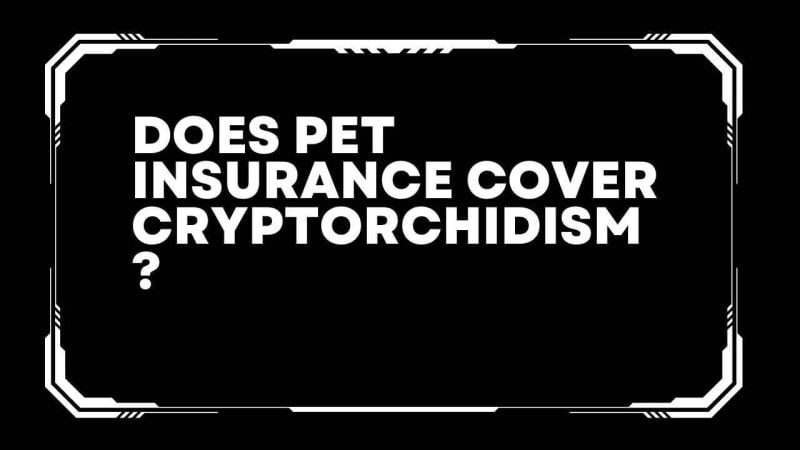When you bring that adorable bundle of fur into your life, the last thing on your mind is the intricate world of pet health issues and insurance policies. Yet, as responsible pet parents, it becomes crucial to understand what’s covered and what’s not, especially for conditions that might not be on the everyday radar. Cryptorchidism, a condition where one or both testicles fail to descend in male pets, is one such issue that many pet owners might not be familiar with, but should be. So, does pet insurance typically cover cryptorchidism? Let’s delve into the details, ensuring you’re well-informed and prepared for every curveball your furry friend might throw your way.
Does pet insurance cover cryptorchidism?
Yes, pet insurance typically covers cryptorchidism, which is the condition of undescended testicles in pets. However, there are several conditions and factors that might affect the coverage:
- Enrollment and Waiting Periods: Coverage for cryptorchidism is subject to the pet being enrolled in the insurance before any signs or symptoms of the condition appear. Additionally, there’s usually a waiting period post-enrollment before the coverage for this condition kicks in.
- Policy Terms and Conditions: It’s crucial to carefully review the terms and conditions of each pet insurance policy to ensure it includes coverage for cryptorchidism. Different policies might have varying terms regarding this condition.
- Neutering as a Treatment: Cryptorchidism is typically treated through neutering. While neutering on its own might not be covered by pet insurance, the necessity for neutering due to a cryptorchidism diagnosis may make the castration surgery and related diagnostics eligible for coverage through pet insurance.
It’s advisable to thoroughly review any pet insurance policy you’re considering and, if possible, consult with the insurance provider to clarify the extent of coverage for cryptorchidism and related treatments.
Understanding Cryptorchidism in Pets
Cryptorchidism might sound like a complex term, but if you’ve ever had a male pet with a “disappearing act” regarding its testicles, you’ve likely encountered it. Let’s dive into understanding this condition and why it’s essential to address it.
Cryptorchidism Simplified
Male dogs and cats are born with their testicles located near the kidneys. Think of it as a journey – within six months after birth, these testicles should make their way down to the scrotum. However, sometimes one or both decide to take a detour or stall on this trip. When they don’t reach their final destination, they’re referred to as cryptorchid or retained testicles. This hiccup can happen both in cats and dogs, though our canine friends tend to experience it more.
How to Spot Cryptorchidism in Your Pet
Your pet can’t tell you what’s wrong, so here are some clues to look for:
- Abdominal discomfort.
- An empty side in the scrotum.
- A significantly smaller testicle compared to the other.
- Your male pet acting, well, very “male” without visible testicles.
Why Address Cryptorchidism?
Leaving cryptorchidism untreated isn’t just a cosmetic concern; it can lead to:
- Tumors in the retained testicle.
- Twisting of the spermatic cord – as uncomfortable as it sounds.
- Difficulty in reproducing.
- A condition where your pet might develop some feminine traits, like hair loss and mammary tissue development.
How is Cryptorchidism Diagnosed?
If by six months you or your vet can’t feel both testicles, it’s time to investigate further. Your vet will attempt to locate the wanderer. It could be hiding:
- Deep in the abdomen.
- In the inguinal canal – the typical pathway to the scrotum.
- Just beneath the skin near the groin.
Based on its location, your vet might recommend a surgical procedure. If you have pet insurance, now would be a good time to check if it covers such surgeries.
Tackling Cryptorchidism: To Neuter or Not?
Given the potential health issues, it’s often advised to neuter cryptorchid pets around the six-month mark. This not only addresses the current problem but prevents possible future complications.
The Genetic Puzzle Is cryptorchidism a family trait?
While not fully understood, there’s a genetic link. Breeding cryptorchid pets might not be wise, as their offspring could inherit the condition. And remember, some insurers might raise an eyebrow (and premiums) if they know you’re aware of the issue and still choose to breed.
Fertility Concerns
While cryptorchid pets aren’t always infertile, their chances of fathering offspring are compromised. They tend to produce fewer, and often abnormal, sperm
How Much Does Dog Cryptorchidism Surgery Cost?
The cost of dog cryptorchidism surgery can vary significantly based on a range of factors including the geographic location, the severity of the condition, the age and size of the dog, and the expertise of the veterinarian performing the procedure. Here are several cost estimates from different sources:
The cost for an abdominal cryptorchid orchiectomy in dogs can range from $100 to $350 depending on the individual dog’s condition. However, the cost of cryptorchidism surgery can range from $500 to $1,500, with some veterinarians charging as much as $2,000 or more for more complex cases. This cost typically includes pre-operative exams, anesthesia, surgical procedures, post-operative care, and necessary medications.
These cost estimates demonstrate the variability in pricing for cryptorchidism surgery, which can be influenced by many factors. It might be worthwhile to contact several veterinary clinics in your area to get a better understanding of the cost you might incur.






2 Comments
can i purchase wellbutrin without prescription in canada
where to get metformin